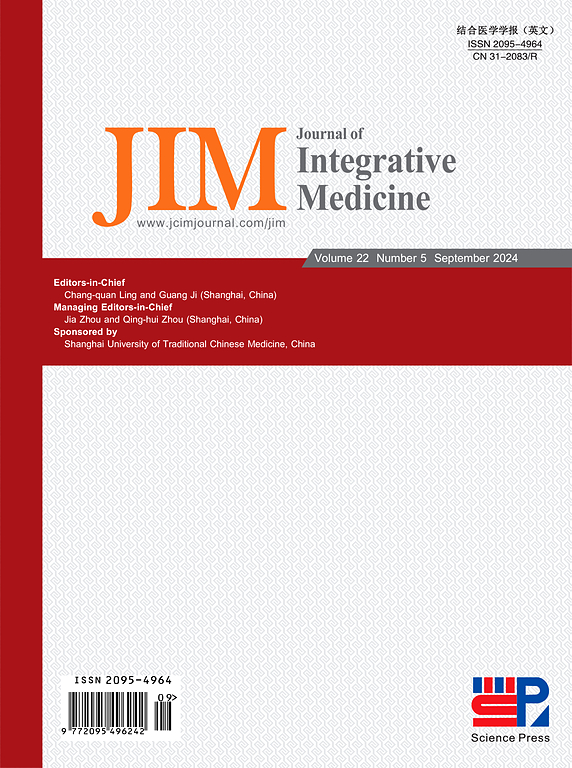Effects of acupuncture needle modification on acupuncture analgesia
IF 4
2区 医学
Q1 INTEGRATIVE & COMPLEMENTARY MEDICINE
引用次数: 0
Abstract
Objective
The analgesic effect of acupuncture has been widely accepted. Nevertheless, the mechanism behind its analgesic effect remains elusive, thus impeding the progress of research geared toward enhancing the analgesic effect of acupuncture. This paper investigated the role of acupuncture needle surface textures on acupuncture’s analgesic effect by creating four experimental acupuncture needles with different patterns of surface augmentation.
Methods
Four types of acupuncture needles with different surface textures (the lined needle, circle needle, sandpaper needle, and threaded needle) were designed. Additionally, the force/torque measurement system used a robot arm and mechanical sensor to measure the force on the needle during insertion and manipulation. To perform acupuncture analgesia experiments, four experimental acupuncture needles and a normal needle were inserted into the Zusanli (ST36) acupoint of rats with inflammatory pain. By comparing the force and torque and the analgesic efficacy of the different acupuncture needles, these experiments tested the role of acupuncture needle body texture on acupuncture analgesia.
Results
The analgesic effects of different acupuncture needle body textures varied. Specifically, the force required to penetrate the skin with the lined needle was not greater than that for the normal needle; however, the needle with inscribed circles and the sandpaper-roughened needle both required greater force for insertion. Additionally, the torque of the lined needle reached 2 × 10–4 N·m under twisting manipulation, which was four times greater the torque of a normal needle (5 × 10–5 N·m). Furthermore, the lined needle improved pain threshold and mast cell degranulation rate compared to the normal needle.
Conclusion
Optimizing the texture of acupuncture needles can enhance acupuncture analgesia. The texture of our experimental acupuncture needles had a significant impact on the force needed to penetrate the skin and the torque needed to manipulate the needle; it was also linked to variable analgesic effects. This study provides a theoretical basis for enhancing the analgesic efficacy of acupuncture through the modification of needles and promoting the development of acupuncture therapy.
Please cite this article as: Sun MZ, Wang X, Li YC, Liu YH, Yu Y, Ren LJ, Gu W, Yao W. Effects of acupuncture needle modification on acupuncture analgesia. J Integr Med. 2025; 23(1): 66–78.
针刺改针对针刺镇痛的影响。
目的:针灸的镇痛作用已被广泛接受。然而,其镇痛作用的机制尚不清楚,从而阻碍了针对增强针刺镇痛作用的研究进展。本文通过制作4种不同表面增强方式的实验针,研究针刺表面纹理对针刺镇痛效果的影响。方法:设计4种不同表面纹理的针(内衬针、圆针、砂纸针、螺纹针)。此外,力/扭矩测量系统使用机械臂和机械传感器来测量针在插入和操作过程中的力。将4根实验针和1根正常针插入炎性疼痛大鼠足三里(ST36)穴,进行针刺镇痛实验。本实验通过比较不同针刺针的受力、扭矩及镇痛效果,检验针刺针体纹理对针刺镇痛的作用。结果:不同针刺针体织构的镇痛效果不同。具体来说,用内衬针穿透皮肤所需的力并不大于普通针;然而,有圆的针和砂纸粗糙的针都需要更大的力量插入。另外,在扭转操作下,衬针的扭矩达到2 × 10-4 N·m,是普通针扭矩(5 × 10-5 N·m)的4倍。此外,与普通针相比,内衬针改善了痛阈和肥大细胞脱颗粒率。结论:优化针针质地可增强针刺镇痛效果。我们的实验针灸针的质地对穿透皮肤所需的力和操纵针灸针所需的扭矩有显著影响;它还与不同的镇痛效果有关。本研究为通过对针刺的修饰来提高针刺的镇痛效果,促进针刺疗法的发展提供了理论依据。本文署名:孙明志,王旭,李玉春,刘永华,于莹,任丽娟,顾伟,姚伟。针刺针刺镇痛的针刺修饰效应。集成医学[J];打印前Epub。
本文章由计算机程序翻译,如有差异,请以英文原文为准。
求助全文
约1分钟内获得全文
求助全文
来源期刊

Journal of Integrative Medicine-Jim
Medicine-Complementary and Alternative Medicine
CiteScore
9.20
自引率
4.20%
发文量
3319
期刊介绍:
The predecessor of JIM is the Journal of Chinese Integrative Medicine (Zhong Xi Yi Jie He Xue Bao). With this new, English-language publication, we are committed to make JIM an international platform for publishing high-quality papers on complementary and alternative medicine (CAM) and an open forum in which the different professions and international scholarly communities can exchange views, share research and their clinical experience, discuss CAM education, and confer about issues and problems in our various disciplines and in CAM as a whole in order to promote integrative medicine.
JIM is indexed/abstracted in: MEDLINE/PubMed, ScienceDirect, Emerging Sources Citation Index (ESCI), Scopus, Embase, Chemical Abstracts (CA), CAB Abstracts, EBSCO, WPRIM, JST China, Chinese Science Citation Database (CSCD), and China National Knowledge Infrastructure (CNKI).
JIM Editorial Office uses ThomsonReuters ScholarOne Manuscripts as submitting and review system (submission link: http://mc03.manuscriptcentral.com/jcim-en).
JIM is published bimonthly. Manuscripts submitted to JIM should be written in English. Article types include but are not limited to randomized controlled and pragmatic trials, translational and patient-centered effectiveness outcome studies, case series and reports, clinical trial protocols, preclinical and basic science studies, systematic reviews and meta-analyses, papers on methodology and CAM history or education, conference proceedings, editorials, commentaries, short communications, book reviews, and letters to the editor.
Our purpose is to publish a prestigious international journal for studies in integrative medicine. To achieve this aim, we seek to publish high-quality papers on any aspects of integrative medicine, such as acupuncture and traditional Chinese medicine, Ayurveda medicine, herbal medicine, homeopathy, nutrition, chiropractic, mind-body medicine, taichi, qigong, meditation, and any other modalities of CAM; our commitment to international scope ensures that research and progress from all regions of the world are widely covered. These ensure that articles published in JIM have the maximum exposure to the international scholarly community.
JIM can help its authors let their papers reach the widest possible range of readers, and let all those who share an interest in their research field be concerned with their study.
 求助内容:
求助内容: 应助结果提醒方式:
应助结果提醒方式:


